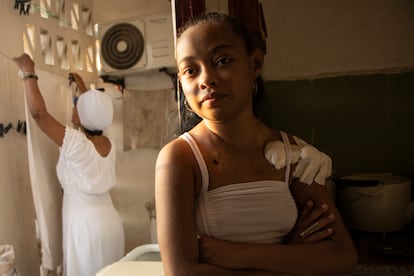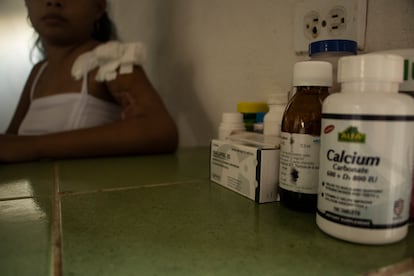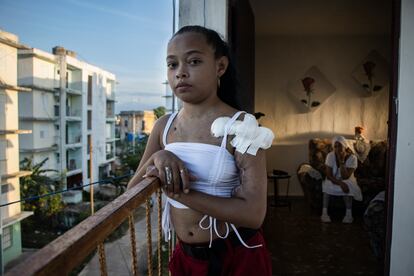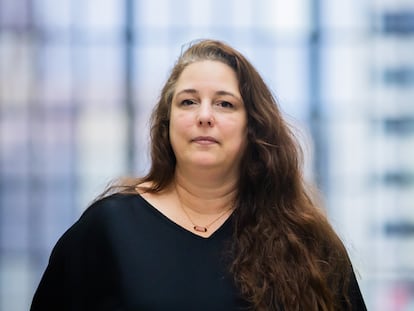The ordeal of kidney patients in Cuba: ‘If you want your daughter to live, you have to get her out of the country’
Faced with a dire shortage of medicines, supplies and medical personnel despite the authorities’ claims about the quality of Cuban healthcare, many patients are considering migrating just to survive. Others cannot afford to even think about it


It’s as if a snake has crept into Ayamey Valdés’s arm… an 11-inch-long snake, thick, deformed and violent. Oftentimes, it seems that she has volcanoes erupting on her skin. They spit blood until she’s left without strength, with her skin dyed a cyanotic blue. That’s when the arteriovenous fistula in her arm bursts: it swells, oozes and hurts.
Sometimes, at the neighborhood grocery store, more than one person has asked her what condition she has. If she’s in the mood, she’ll explain that she’s receiving hemodialysis. When she’s not up to explaining her medical history, she’ll tell them that she’s brave, that she got into a big fight, that her arm was crushed.
There are times when Ayamey misses drinking a full jug of water and not just 255 milliliters a day. There are times when she gets impatient. And, once in a while, she screams – with a raspy, childlike voice – that she wants to die.
Ayamey is 19 years old. And since she was 10, her routine has been the same. On Tuesdays, Thursdays and Saturdays, she goes to the hemodialysis room at the Pediatric Hospital in Central Havana. From eight in the morning, she remains in cubicle four, with white, green and cream-colored walls, where the only television set broke some time ago. Until noon, she’ll be connected to the dialyzer, patiently passing the hours while the machine extracts the blood from her body, cleans it and returns it to her. During this process, Ayamey checks her phone, jokes with a nurse, or chats with the other patients.
Today, she says she feels ok. Her blood pressure is a little low, but it’s fine. Her voice sounds cheerful, but after three and a half hours of hemodialysis, she’ll be fiercely tired. She’ll get home, lie down on the bed and sleep for as long as she wants. There are days when she’ll feel like vomiting, others when powerful headaches will immobilize her.

“Sometimes, I get a little desperate,” she sighs. “I tell my mom that I’m tired, that I’ve been patient long enough. Sometimes, I don’t feel like going to the hospital at all… but what am I supposed to do? If I don’t go, I’ll die.”
Ayamey is 4′9 and weighs 86 pounds. Her body stopped growing a long time ago due to chronic kidney failure and the lack of hormones available in the hospital. Since 2016, every week, she travels from her home in the borough of Guanabacoa to the Pediatric Hospital, where every doctor, nurse and nursing assistant knows her. As a child, Ayamey – wearing her hospital gown – would race through the clinic’s hallways, participating in the improvised wheelchair racing competition. “She’s very sweet, she doesn’t complain,” says Dr. Mercedes, a pediatrician and nephrologist. “I met her when she was 13 years old. She couldn’t go to school. She was very intelligent; she wanted to do many things.”
Ayamey stopped attending classes when she was diagnosed with the disease, after suffering from glomerulonephritis: the blood vessels in her kidneys were so damaged that they couldn’t filter waste from her blood. The first symptom was a rash on her skin. Doctors told her it was dengue. The next day, she urinated blood and had a fever. Doctors assured her that this was normal, perhaps related to menstrual problems. Then, her knees began to swell. Doctors advised her to drink water, that it could be a kidney infection. But for 36 hours, she couldn’t urinate and her kidneys collapsed. Finally, she was sent to the Pediatric Hospital.
“I remember that they put me on the stretcher and I began to ask what they were going to do to me. Nobody answered. They just told me: ‘Don’t worry, it won’t hurt. ' They turned my face away and, when they inserted the needle into my neck, I started screaming. The anesthesia did nothing.”

From then on, there was one complication after another. With treatments, Ayamey partially recovered her kidney function. But exactly one year later, she returned to the Pediatric Hospital almost permanently. In her 19 years of life, she’s come close to death many times… and she’s also seen it. She’s the last one left among the children she met long ago in the hospital. Ayamey has said goodbye to all of them, one by one. She remembers one friend in particular, a boy younger than her, who was on hemodialysis in the bed next to her.
“When he died, I didn’t want to go back to the hospital. I’ve had moments when I’ve been depressed. I’ve always been a very happy girl, but I’m not made of iron,” she sighs.
It seems that such a tiny body shouldn’t be able to handle so much. Her body is the exact map of her illness, a geography shaped by punctures, stretch marks, and wounds from the nine catheters that have been placed in her and that are constantly becoming infected. Someone even punctured one of her lungs by blindly placing a catheter. She suffers from gastritis, due to the medications she takes. She also deals with hypertension and chronic anemia. She barely has any vascular access.
Once, due to fluid retention in her body, she had 17 seizures. That was probably the saddest day in the life of Yurama Bolaño, Ayamey’s mother, who saw how her daughter’s eyes went white while she was trapped between spasms and tremors.
A few days ago, the doctor told Yurama, without mincing words, that there’s no possibility of kidney transplants in Cuba. If she wants her daughter to live, she’ll have to take her out of the country. “She’s my only daughter and this is something that I never expected. The sadness that I carry is incalculable,” she laments. “But I don’t have any money… how can I get her out of here?”
Last year, Dr. Alexander Mármol Sóñora, vice president of the Cuban Society of Nephrology, went so far as to say that “in Cuba, nephrology is having one of its best moments.” However, this isn’t what doctors and patients believe. For at least the past four years, kidney transplants have hardly been performed on the island. The lack of medicines and medical supplies is the focus of complaints from many families amidst the health crisis that the country is going through. But what perhaps had never happened in Cuba until recently — even though the island is advertised as a healthcare paradise — is that there also aren’t enough specialized medical personnel to even perform organ transplants.
***
When Héctor González had a ticket from Aruba Airlines in his hands, the doctors at the Hermanos Ameijeiras Hospital, one of the most renowned in Cuba, rushed to show him how to treat the entry hole of a catheter in his heart. It was probably going to be more difficult than crossing a river, climbing a fence, or crossing into the United States. The cardiologist recommended that Héctor cover himself with gloves, a cap and a face mask to avoid an infection that could be fatal, lock himself up in places where there was no air, grab alcohol or iodine and clean the hole.
During his last hospital stay, Héctor, 41, saw five kidney patients like him die. “One day, you show up and you don’t see someone. At that moment, you get a lump in your throat. You know that they’ve either been admitted into inpatient care, or they died,” he says. Among those he saw die was Lino, a strong, healthy man who, after finishing hemodialysis, always went back to to work as a hospital elevator operator.
Five years have passed since Héctor was diagnosed with chronic kidney failure, the disease that’s now the eighth-biggest cause of death in Cuba. His body has endured more than 30 temporary catheters. These are frequently infected and have occasionally blocked his veins.
“In Cuba,” he explains, “they almost never put in permanent catheters, because there aren’t any. [The government] doesn’t buy them. For me, that’s a crime. You know that this is going to affect the patient and yet, you’re still doing it. I have holes all over my body from those catheters.”
On one occasion, when the medical team couldn’t place a catheter due to the lack of space on his body, he went almost a month without undergoing hemodialysis. Subsequently, fluid accumulated in the membrane surrounding his heart and he had to undergo surgery for a pericardial effusion.
Héctor remembers the fatigue he felt, which he also noticed in most of the doctors. They had no gloves to work with, nor fresh needles or filters. Everything had to be reused. “Sometimes, in the room, there were cotton balls with blood on the floor. Once, I found a cockroach crawling on top of the dialyzer. But one of the things that made me really think about leaving Cuba was that the dialyzers in the filters are constantly being washed and recycled, which is why more than half of the patients in my room had Hepatitis C.”
Héctor knew that crossing Central America and Mexico could cost him his life, but nothing assured him that staying in Cuba could save him. In his home country, he probably would never have the possibility of a kidney transplant, especially with nobody in his life able to donate the organ.
According to the latest official data, in 2022, there were 340 patients per million inhabitants receiving dialysis methods in Cuba’s 57 nephrology departments. That year, some 4,700 patients were living thanks to renal replacement therapies, either dialysis or transplants. And, according to Dr. Antonio Enamorado Casanova, coordinator of the National Donation and Transplant Program within the Ministry of Public Health, at that time, there were more than 1,500 patients who had received transplants.
The authorities have boasted that Cuba is the country with the second-most kidney transplants in Latin America, with an organ donation rate of 13.7 per million inhabitants in 2019. But in 2020, Cuban hospitals, overwhelmed by the Covid-19 pandemic, stopped performing kidney transplants. In 2022, government media announced that these operations were resuming, after almost two years of being “on hold.” However, patients and health professionals consulted by EL PAÍS deny this version of events and emphasize that kidney transplants aren’t being performed at all… at least, not with organs from deceased people.
On the condition of anonymity, a doctor who worked at the Amalia Simón Provincial Clinical Surgical Hospital, in the city of Camagüey — a doctor who also happens to be a kidney patient — maintains that the kidney transplant program in Cuba has been suspended since early 2020, even before the increase in Covid-19 cases. “All patients are condemned to die,” he affirms.
There’s no official data available regarding the number of transplant patients in recent years. However, the International Registry of Organ Donation and Transplantation (IRODaT) shows that only 13 transplants were performed in Cuba in 2023. Patients say that most of these kidneys came from donor relatives.
Héctor has no doubt that many of the organs from deceased patients don’t reach living ones. He remembers that, in the middle of last year, everyone at the Hermanos Ameijeiras Hospital was whispering that the only kidney available was reserved for someone close to Miguel Díaz-Canel, the president of Cuba.
“There was a boy who was ready for a transplant, the next kidney was his,” Héctor recalls. “Suddenly, [the doctors] told him they couldn’t operate. Instead, they operated on someone else, who showed up out of nowhere. That hasn’t been the only time that [the authorities] have given priority to a relative of the leader.”
The doctor who asked to remain anonymous says that, in Cuban hospitals, most of the time, there are no human leukocyte antigens to do compatibility studies. Hemodialysis in Camagüey, which used to take place regularly on Thursdays and Fridays, is constantly being suspended due to a lack of supplies. Most kidney patients, the doctor explains, are malnourished. “In the hospitals, they violate the [kidney-friendly] diet and give [the patients] anything to eat. [And] doctors sometimes have only one catheter for several patients… they have to decide who lives or who dies at that moment.”
Added to the lack of supplies is the lack of specialized personnel. While government media maintains that Cuba is the country with the most nephrologists in Latin America per million inhabitants, many of the health workers have joined the exodus of the almost two million Cubans who have left in the last three years. Others prefer to work in any private sector job that pays more than the average salary of a Cuban doctor, which runs between $20 and $40 a month. In 2022, the National Statistics Office of Cuba (ONEI) revealed that the country lost 12,000 doctors that year.
“In Camagüey, there’s only one angiologist who does transplants. The rest of the team no longer works in the healthcare sector,” the doctor tells EL PAÍS. “Of the 16 specialized nurses who work in the transplant room for four work shifts, there’s only one [surgeon].” Dr. Mercedes, for her part, notes that, in the Pediatric Hospital of Central Havana, there was only one older doctor who was doing transplants. “All those he trained left the country.” She herself left a few years ago through Mexico with her daughter. Her salary as a doctor, between 5,000 and 6,200 Cuban pesos a month, or about $20, wasn’t enough to live on. “The working conditions drove me crazy, because there are no nephrologists in Cuba, at least not in pediatrics. I had already left that hospital, but I had to keep going back to do shifts because there was nobody else available. All for the same salary. I decided that it was time, I had to leave.”
The doctor from Camagüey also wants to leave, but he doesn’t have the means to. However, in November of 2023, Héctor bought a ticket for $1,500 and arrived in Managua, Nicaragua, to undertake the route that thousands have traveled since President Daniel Ortega lifted visa requirements for Cubans in 2021.
***
On December 4, 2018, someone was supposed to be saved at the Pediatric Hospital in Central Havana. The kidney from a deceased person arrived, which was going to prolong the life of a child. The doctors looked for the surgeon, Dr. Labrada. They prepared the operating room. They called the possible recipients. Some arrived by taxi, others waited for the ambulance. The tests, and the anxiety, began.
“Children in Cuba aren’t on a waiting list: they’re a priority,” Dr. Mercedes explains. Among the patients waiting for kidneys, the most suitable one is chosen, one who’s compatible with the donor. “[The child] must have an acceptable hemoglobin [level]; they cannot have presented an infection during a certain period of time. If there are several suitable children, you choose the one who’s clinically in the best condition, or the one who needs it the most at that moment due to their age. Because if it’s a small child, there’s a chance that another transplant will appear… but if there’s a child who’s about to become an adult, where the [likelihood] of being suitable for a transplant changes completely, then you would try to prioritize that child.”
Ayamey, who was 13 years old at the time, was the chosen one. She still remembers the white and pink pajamas she was wearing on the day of the operation. She was relatively calm. Her mother, nervous, paced up and down the corridors of the Pediatric Hospital.
Dr. Mercedes was part of the transplant team. “That night was incredible,” she recalls. But six or seven hours passed from the time it was known that an organ was available until Ayamey entered the operating room. This was a longer time than was expected: an organ that’s about to be transplanted isn’t receiving blood. “It’s about making [the time period] as short as possible… but that’s how it is in Cuba. There’s no transportation, there are no ambulances to look for [those on the waiting list],” she explains.
The operation lasted about six hours. In principle, there were no complications. The problem came when the surgeons joined the girl’s arteries and veins with those of the kidney. “There was no immediate diuresis; that is, the kidney didn’t ‘urinate,’” the doctor explains. After a few hours, “we began to see that blood wasn’t coming out correctly; the organ wasn’t being transfused properly.”
Ayamey felt the fatigue of an operation that had lasted until three in the morning. In her lethargy, she heard the voices of the doctors and understood that something was wrong. Dr. Mercedes gave the news to Yurama Bolaños. “Her mother told me: ‘Don’t take it away, don’t [tell them to] remove the kidney,’” she says. “I told her that it wasn’t working [and] that, if she had an acute reaction, the patient could lose her life. We suffered a lot. But the kidney had to be removed that same day.”
When Ayamey woke up and learned that the transplant hadn’t worked, she didn’t shed a tear. Her mother, clinging to the doctor, told him to please get another kidney for her daughter. Until today, it hasn’t been possible. Ayamey turned 19 and has since stopped receiving care at the Pediatric Hospital. She has lost the few benefits guaranteed to minors in Cuba. Now, she’s being treated at the Miguel Enríquez Clinical Surgical Hospital in Havana. Here, she must bring her own sheets, syringes, filters and arterial lines for hemodialysis.
Some days, there’s no iron. Other days, there’s no erythropoietin. Sometimes, there’s no rocaltrol, or there’s nothing for hypertension. It all has to be purchased on the black market. Weeks ago, her mother asked for volunteers to donate blood, because her daughter has very low hemoglobin levels. She’s been told that, in Havana, there are people selling quantities of blood for up to 15,000 Cuban pesos ($50 dollars)… an amount that’s difficult for her to pay, but that she’ll have to find. Recently, the fistula burst and Ayamey was rushed into the operating room. She was on the verge of losing her left arm. Now that she’s recovering, her mother sits in the waiting room. She explains that she’s feeling “anguish, a tightness in the chest.”
“I think about when she was little, when she was a happy girl. She had a normal life,” her mother says quietly. “Sometimes, I go into her room and see her with teary eyes. She asks me when she’ll be able to get a transplant, if it will ever happen.”
***
Héctor landed in Nicaragua with a backpack full of medicines and medical supplies that had been sent to him from abroad. The authorities, alarmed, asked for explanations. Nothing convinced them.
“That is, until I lifted up my sweater and showed them the catheter. Then, they left me alone,” he says.
He was weak, almost cadaverous. The latest treatments had resulted in him quickly losing 22 pounds. For the journey, the doctors recommended that he take zinc and calcium in case hemodialysis was delayed, and take care of his fluid intake, in order to avoid pulmonary edema.
At the airport in Managua, he met the coyote — the human smuggler — whom he had contacted earlier on Facebook. They set off. He was worried about the journey ahead, about hemodialysis. He didn’t know when, how or where he would filter the toxins and water from his blood. He searched Google for clinics for kidney patients, most of them located far from the path he had to follow. His first stop was a church on the border with Honduras. Then, he crossed Guatemala. Hector’s legs began to swell; they looked like they were about to explode. On the trip, he was careful to consume only 30 milliliters of liquid and just one meal per day. People around him wondered how it was possible that he barely ate, when there were so many varieties of fruits, sodas and breads around. He never allowed himself any excess.
One Sunday, he arrived in Tapachula, Mexico, after crossing the Suchiate River on a homemade raft. The next thing he did was to get on a truck. It was two in the morning and there were more than 40 people with him. Their bodies were jammed together, like a human puzzle. Héctor began to have trouble breathing. He asked to get down, for the driver to please let him out. The human smuggler got angry, demanding that Héctor follow the rules.
“I opened my shirt and showed him the catheter. I told him: ‘It’s not that I don’t want to, brother, it’s that I can’t. If I make the trip under these conditions, something could happen to me and it will be a problem, even for you.’”
He got off the truck and managed as best he could. The first thing he did was find a place for hemodialysis. When the Hemoquid Clinic in the center of Tapachula opened its doors in the morning, Hector was the first patient. It had been five days since he had undergone hemodialysis… far too long.
“I already felt weak. I was short of breath, very weak.”
During the hemodialysis sessions, Hector would constantly compare the well-equipped and clean Mexican clinic with the Cuban hospitals. In other moments, he would listen to music, call his family, or research how he would cover the remaining part of his journey. It was a friend who recommended a different coyote.
Not everyone wants to take care of a sick person, but the new smuggler was attentive. He took the trouble to ask Héctor what days his treatment was due, so as to calculate the time of the trip to Mexico City. He also gave instructions to his network of contacts to take Héctor to clinics and pharmacies if necessary.
“The people who are in this business see [migrants] as merchandise,” the coyote shrugs. He speaks with EL PAÍS on the condition of anonymity. He knows that there are many abuses and scams, but he considers himself to be a “very human and sensitive” guy. “You have to warn the relatives or people who hire us about the situations that can arise,” he explains. “Héctor’s case was very special because of his hemodialysis. We had to take it into consideration.”
Héctor didn’t think he was going to make it. He left Tapachula on a Friday morning with a group of 21 Cubans, Dominicans and Ecuadorians. He did some parts of the journey on a motorcycle, others in a van. He walked through checkpoints. The catheter came loose more than once due to sweat. His feet were extremely swollen.
“At one point, I collapsed. But another Cuban grabbed me by the arm and said: ‘Come on, you have to get there.’”
With his last ounce of strength, he arrived in Mexico City, where he was quickly taken to a clinic. Once he recovered, the coyote looked for the fastest, safest and most comfortable way to get him to the border. In the early hours of December 4, 2023, the day he was going to cross into the United States, Héctor thought he was dying. He crossed a cotton field, a mudhole, climbed an improvised ladder to scale the border wall and, with a rope, let himself fall on the other side.
“I looked around and said, ‘Damn, I did it, I’m here.’”As Border Patrol approached, Hector showed them the catheter and asked for urgent help.
It’s been a year since agents took Hector to a nearby hospital. A year since he applied for political asylum, settled in Florida, was granted Medicaid insurance, resumed his hemodialysis treatments and regained his energy. Now, he’s preparing to undergo a kidney transplant at the Miami Transplant Institute (MTI). He knows the next journey is a long one. But he has his backpack ready.
Translated by Avik Jain Chatlani.
Sign up for our weekly newsletter to get more English-language news coverage from EL PAÍS USA Edition
Tu suscripción se está usando en otro dispositivo
¿Quieres añadir otro usuario a tu suscripción?
Si continúas leyendo en este dispositivo, no se podrá leer en el otro.
FlechaTu suscripción se está usando en otro dispositivo y solo puedes acceder a EL PAÍS desde un dispositivo a la vez.
Si quieres compartir tu cuenta, cambia tu suscripción a la modalidad Premium, así podrás añadir otro usuario. Cada uno accederá con su propia cuenta de email, lo que os permitirá personalizar vuestra experiencia en EL PAÍS.
¿Tienes una suscripción de empresa? Accede aquí para contratar más cuentas.
En el caso de no saber quién está usando tu cuenta, te recomendamos cambiar tu contraseña aquí.
Si decides continuar compartiendo tu cuenta, este mensaje se mostrará en tu dispositivo y en el de la otra persona que está usando tu cuenta de forma indefinida, afectando a tu experiencia de lectura. Puedes consultar aquí los términos y condiciones de la suscripción digital.
More information
Archived In
Últimas noticias
The metaverse, four years later: Is it finished or just at a standstill?
$3,000 and a plane ticket: The United States increases incentives for migrants to self-deport before the end of the year
Charles Dubouloz, mountaineering star, retires at 36 with a farewell tour inspired by Walter Bonatti
From the White House to diplomatic gifts: Lego wins over adult fans, brick by brick
Most viewed
- The low-cost creative revolution: How technology is making art accessible to everyone
- Christian Louboutin: ‘Young people don’t want to be like their parents. And if their parents wear sneakers, they’re going to look for something else’
- All the effects of gentrification in one corner of Mexico’s Colonia Roma
- Christmas loses its festive spirit: ICE fears cast shadow over religious celebrations
- Liset Menéndez de la Prida, neuroscientist: ‘It’s not normal to constantly seek pleasure; it’s important to be bored, to be calm’










































